The History of Armenia-Azerbaijan Conflict
| The Historical background , causes and essential elements of the present day Armenian-Azerbaijan conflict
1.
The resettlement of Armenians in
the territory of Azerbaijan
|
| The Armenia Azerbaijan conflict |
|
The conflict is rooted in
expansionism and a policy of
aggression aimed at expanding
the territory of Armenia by
force at the expense of the
territory of another sovereign
state.
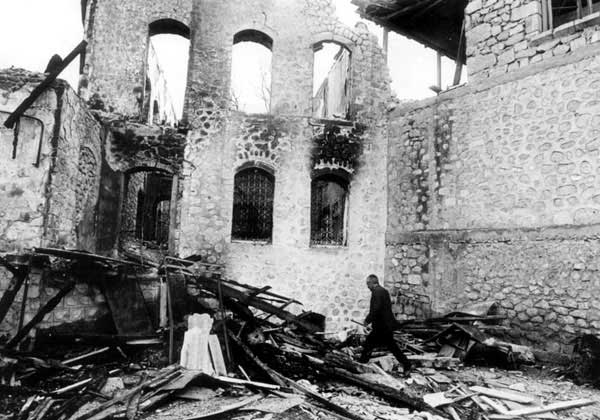 Separatists
in the local council of the
Mountainous (Nagorno) Karabakh
Autonomous Region (MKAR) of the
Azerbaijan Soviet Socialist Republic
adopted a unilateral decision to
secede from Azerbaijan in February
1988. (According to the population
census of 1989, the population of
the MKAR was 186,100, of which
138,600 were Armenians (73.5%) and
47,500 Azerbaijanis (25,3%). In
December 1989 the Parliament of
Armenia decided to annex Mountainous
Karabakh, an integral part of
neighboring Azerbaijan, in a move
grossly violating international laws
and norms of conduct. By doing so,
Armenia has clearly followed an
example set by Nazi Germany in
annexing German-populated areas of
the neighboring countries on the eve
of the World War II. Separatists
in the local council of the
Mountainous (Nagorno) Karabakh
Autonomous Region (MKAR) of the
Azerbaijan Soviet Socialist Republic
adopted a unilateral decision to
secede from Azerbaijan in February
1988. (According to the population
census of 1989, the population of
the MKAR was 186,100, of which
138,600 were Armenians (73.5%) and
47,500 Azerbaijanis (25,3%). In
December 1989 the Parliament of
Armenia decided to annex Mountainous
Karabakh, an integral part of
neighboring Azerbaijan, in a move
grossly violating international laws
and norms of conduct. By doing so,
Armenia has clearly followed an
example set by Nazi Germany in
annexing German-populated areas of
the neighboring countries on the eve
of the World War II. Armenia started to establish unconstitutional structures in the Mountainous Karabakh (MK) region of Azerbaijan. The military formations as well as a huge amount of weapons and ammunition were shipped on the territory of Azerbaijan. A military bridgehead was set up to conduct an armed aggression against Azerbaijan.
Full-scale hostilities in the
zone of the Armenia-Azerbaijan
conflict escalated at the end of
1991-early 1992. Ethnic
cleansing, conducted by the
Armenian armed forces on the
territory of the Mountainous
Karabakh region, reached its
climax during the massacre of
Khojaly, an Azerbaijani town in
the region, in February l992.
More than 800 peaceful
residents, including women and
children, were slaughtered in
what Human Rights Watch called
«the largest massacre of the
conflict.» The Armenian
aggression spread far beyond the
administrative boundaries of the
region to the rest of
Azerbaijan. Between May 1992 and
May 1994, six districts of
Azerbaijan outside MKAR were
occupied.
Thus, as a result of aggression
against the Republic of
Azerbaijan, more than 17.000 km2
(approximately 20% of the
territory) were occupied, more
than 18.000 persons were killed,
over 50.000 left wounded or
maimed, and almost 900
settlements, 100 thousand
dwellings, more than 600
schools, and 250 medical
institutions were looted or
ruined. The number of internally
displaced persons (IDP) from the
occupied Azerbaijani lands and
refugees from Armenia reached
about 1 million people. In a
country of 8 million people,
this represents the highest per
capita number of IDP in the
world.
With 20% of its territory seized, Azerbaijan is facing a humanitarian disaster. Limited humanitarian aid coming to Azerbaijan falls short of the basic needs of the people affected by the conflict. Aghdere and Aghdam districts of Azerbaijan were seized by Armenian armed forces following the adoption of UN Security Council Resolution 822 (1993) of 30 April 1993,which condemned occupation of the Kelbajar district; the Fizuli district was seized after the adoption of Security Council Resolution 853 (1993) of 29 July 1993, condemning the seizure of the Aghdam district; and the Djebrail and Kubatly districts were seized after the adoption of Security Council Resolution 874 (1993) of 14 October 1993. In its resolution 884(1993) of 11 November 1993, the Security Council condemned the occupation of the Zangelan district and the town of Horadiz, attacks on civilians, and bombardments of the territory of Azerbaijan. In its resolutions, the UNSC underscored respect for the sovereignty, territorial integrity and inviolability of the borders of Azerbaijan, and the inadmissibility of using force to annex territories. It also demanded the immediate cessation of armed hostilities and hostile acts, and the immediate, full and unconditional withdrawal of all occupying forces from the occupied areas of Azerbaijan. Despite the unequivocal demands of the Security Council, the Republic of Armenia still occupies Azerbaijani territory and increases its military presence there. Illegal supplies of the Russian arms and equipment to Armenia from 1994 to 1996 greatly facilitated the Armenian aggression. A military cooperation agreement between the Russian Federation and the Republic of Armenia, signed on August 29, 1997, finalized the military alliance between the two states. By signing the agreement, the Russian Federation compromised its position as a Co-Chair of the OSCE Minsk Process, which mediates the conflict. Azerbaijan considers that this agreement aggravates the situation in the region, and undermines efforts to reach a peaceful settlement of the Armenia-Azerbaijan conflict and to strengthen security in the region. Despite the above, the cease-fire regime, negotiated on May 12, 1994, has been generally observed. Efforts aimed at releasing POWs and hostages are continuing under the aegis ICRC. From 1993 to 1998, 357 persons were released. However, there are reports about Azerbaijanis still detained in Armenia and on the occupied territories. The negotiation process - International mediation on settlement of the conflict started in February 1992, within the framework of the Organization for Security and Cooperation in Europe (OSCE) Minsk process. The Minsk group was established to negotiate political settlement of the conflict. After occupation of the Azerbaijani territories, the UN Security Council adopted Resolutions 822, 853, 874, 884 that demand immediate and unconditional withdrawal of Armenian armed forces from the territory of Azerbaijan and return of refugees and internally displaced persons to their homes. In accordance with decisions of the OSCE Budapest Summit (1994) the institute of Co-Chairs, of the Minsk conference was established «to conduct speedy negotiations for the conclusion of a political agreement on the cessation of the armed conflict («Political Agreement»), the implementation of which would have eliminated major consequences of the conflict for all parties and permit the convening of the Minsk Conference.»
Thereby, the
Budapest Summit
adopted a legal
two-stage
framework of the
conflict
settlement
process:
1) First stage - elimination of consequences of the armed conflict by implementation of the agreement, i.e., full liberation of all occupied territories and ensuring return or IDP's to their homes: 2) Second stage - elaboration and adoption of a comprehensive peace settlement at the Minsk conference. The Budapest Summit also adopted a decision to establish an OSCE peacekeeping operation after the conclusion of the political agreement. Later three main principles of the settlement of the Armenia-Azerbaijan conflict were formulated in the Statement of the OSCE Chairman-in-Office at Lisbon Summit, 1996. They are the following: - Territorial integrity of Armenia and Azerbaijan; - Legal status of Mountainous Karabakh defined in an agreement based on self-determination, which confers on Mountainous Karabakh the highest degree of self-rule within Azerbaijan; - Guaranteed security for Mountainous Karabakh and its whole population, including mutual obligations to ensure compliance by all the Parties with the provisions of the settlement. These principles were supported by all 53 OSCE state-participants except Armenia. Since November 1996, Armenia has unilaterally ceased direct consultations between the two countries and only recently consultations were restored. After the Lisbon Summit and establishment of an institute of the triple Co-Chairmanship (Russia-France-USA), only one round of negotiations has taken place, in April 1997. Further, the process of settlement was developing as follows: June-September, 1997, the Co-Chairs elaborated and submitted a new document for consideration of the Parties, envisaging a two-staged conflict settlement according to the following scheme: First stage - Liberation of 6 occupied districts, outside MKAR (except Lachin district), - Return of civilians and restoration of communication links. Second stage - Reaching solution on Lachin and Shusha districts and adoption of the main principles of the status of the Mountainous Karabakh region. October 1, 1997, Azerbaijan officially informed Co-Chairs on its consent to the document at the basis for the upcoming negotiations. October 1997, in Strasbourg the Presidents of Azerbaijan and Armenia made a joint statement on readiness to resume negotiations on the basis of Co-Chairmen's proposals. December 1997, in Copenhagen, a report of the Co-Chairs, emphasizing the need to continue efforts on settlement of the conflict on the basis of Lisbon principles and proposals of Co-Chairs, was distributed at the OSCE Ministerial Council's meeting. May 13-17, 1998, during a visit of the Co-Chair's to the region, Armenia, under new president Robert Kocharyan officially recalled the early consent of former President of Armenia (L. Ter-Petrosyan) to stage-by-stage proposals. November 9, 1998, the Co-Chairs introduced new proposal based on a Russian-designed concept of «common state». Azerbaijan from the very beginning refused to accept this proposal, and on November 19 officially informed the mediators of the unacceptability of this proposals. Azerbaijan confirmed its readiness to resume negotiations within the OSCE Minsk Group on the basis of the Co-Chairs' proposals of September 19, 1997. November 20, 1998, the delegation of the Azeri community of MK officially rejected proposals of November 9, and on November 25, Armenia and the Armenian community of MK stated the agreement with these proposals. December 2-3, 1998, during the OSCE ministerial meeting in Oslo, the Chairman-in-Office appealed to the parties to the conflict to resume negotiations immediately in the framework of the Minsk Group and to Co-Chairs to continue their efforts. Currently the Co-Chairs are pursuing their objective to present a compromise settlement plan to the conflict based on the principles of international law. |
| The beginning of the conflict |
|
The Armenia's claims on
Azerbaijani lands, as well as
the Upper Karabakh formed pars
of its strategy of the
establishment of the Great
Armenia.
 Therefore,
Armenia always tried to make use
of favorable conditions to
achieve their goals. When
pro-Armenian M.S.Gorbachyov was
elected the head of USSR in
1985, Armenians intensified
their activity again. Therefore,
Armenia always tried to make use
of favorable conditions to
achieve their goals. When
pro-Armenian M.S.Gorbachyov was
elected the head of USSR in
1985, Armenians intensified
their activity again.
The support and protection of the Soviet government to armed Armenian separatists was coming to light during that period. In order to implement his mean plans connected with the autonomous province of Nagorno Karabakh, Mikhail Gorbachev distanced the most important obstacle - Heydar Aliyev - from the political bureau. After that Armenian academician A.Aganbekyan of Gorbachov's grouping, reported that he had made a proposal to the Soviet leadership concerning the Upper Karabakh and expressed hope that the problem will find its solution in the conditions of democracy and reconstruction. Once underground Armenian Committee for Karabakh and its terrorist organization Krunk (Crane) in the Autonomous District of Upper Karabakh started operating openly and the movement Miatsum movement was formed at that time. This movement was backed by Armenia, Autonomous District of Upper Karabakh, Moscow leadership and the potential of USSR and world Armenians. The events acquired more aggressive form in 1988. The wave of meetings of separatists and Armenian nationalists captured Yerevan and Stepanakert in February. The session of the council of Autonomous Upper Karabakh District appealed to the Supreme Council of Azerbaijan SSR for consideration of the status of the district February 20.
They managed to create an incorrect view of the world community on Upper Karabakh through intensive propaganda and strong Armenian Diaspora in foreign countries. Therefore, they started to hold propaganda openly. The leadership of Azerbaijan and its community was unprepared for the new tactics of Armenian separatists and their supporters. The murder of two young Azerbaijanis, wounding of 19 people by Armenian separatists in Askeran February 20, resulted in the preparation of policy against the plans of Armenians. In late February the special service bodies and organs of State Security of SSSR committed a tragedy in the big industrial city of Azerbaijan-Sumgayit. The causes of Sumgayit tragedy soon came to light. That step targeted Azerbaijanis living in Armenian and was used to part Upper Karabakh from the Soviet Azerbaijan. "4 residents of Mehmandar village of Azerbaijan south to Yerevan were killed on March 10. Over 100 houses were destroyed and residents were evicted from the Azerbaijani villages of Ararat region on March 25. In mid March Armenians again attacked Azerbaijani villages near Yerevan….". The barbarism of Armenians against Azerbaijanis rose again.
The leadership of Azerbaijan, beginning with A.Vezirov, submissive to Moscow, stood on the position of compromises to betrayers and aggressors of its people. Finally, Moscow undertook one more step to part the Autonomous Province of Upper Karabakh from the Azerbaijan SSR: the Presidium of the USSR Supreme Council approved a resolution "On special form of government in the Autonomous Province of Upper Karabakh" on January 12, 1989. The aim was obvious: The Special Governing Committee, established in the Autonomous Upper Karabakh Province was to provide for the delivery of Upper Karabakh to Armenia. However, as a result of a democratic struggle of Azerbaijani people aware of that, the Special Governing Committee was abolished on November 28. Yet the structure was replaced by a new one-the Organizational Committee. Armenia, making use of it, carried out an anti-constitutional decision on annexation of Upper Karabakh to Armenia on December 1. That was the open violation of the territorial integrity of the Soviet Azerbaijan. As expected, Moscow shut its eyes to the fact of this violent intervention, thus deteriorating the situation. The leadership of USSR, led by Gorbachov, undertook one more cruel step against Azerbaijan. Baku was chosen the main target. The Soviet Union violating the constitutional responsibilities before the people, bringing large troops, armed with up-date techniques and guns, committed bloodshed in Baku on the night of January 20, 1990. Armenian soldiers and militants also took an active part in committing the Baku tragedy. However, the tragedy of January 20 could not undermine the control of Azerbaijan it even strengthened the struggle of the people for the independence and territorial integrity. The next day Heydar Aliyev came to the Azerbaijan's representation in Moscow, exposed the criminal actions of Soviet leadership and expressed his support for the justice Salvation struggle of Azerbaijani people. The Supreme Council of the Soviet Azerbaijan declared the restoration of the state independence on August 30, 1991 and approved the Constitutional act on the national independence on October 18. Armenian separatists of Upper Karabakh took advantage of the situation and continued creating political structures. They declared the establishment of a puppet body named The Upper Karabakh Republic in September of 1991. The Azerbaijan Republic did not accept this structure and the status of the Autonomous Province of Upper Karabakh was abolished on November 26. The collapse of USSR in late 1991 was followed by the change in the geopolitical situation on post-Soviet area. Armenian in fact declared an open and unfair war against Azerbaijan. Armenian military troops, violating the borders of Azerbaijan, entered Karabakh and conjointly with Armenian separatists of Upper Karabakh occupied Azeri lands.
|
| Undeclared war against Azerbaijan |
|
Following the events of February
1988, separatist groups of the
Autonomous Nagorny Karabakh
Province and Armenian militants
launched hostilities for
invasion of the Nagorny
Karabakh.
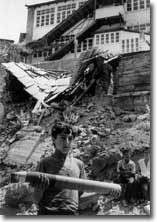 Following the events of February
1988, separatist groups of the
Autonomous Nagorny Karabakh
Province and Armenian militants
launched hostilities for
invasion of the Nagorny
Karabakh. They were soon joined
by the USSR troops stationed in
Armenia and Nagorny Karabakh.
Thus, the events similar to
those after the Tsarist regime
break-up in February 1917
occurred following the collapse
of USSR. Armenian militants,
serving within Soviet Army
united against Azerbaijanis and
launched military actions from a
common front.
Following the events of February
1988, separatist groups of the
Autonomous Nagorny Karabakh
Province and Armenian militants
launched hostilities for
invasion of the Nagorny
Karabakh. They were soon joined
by the USSR troops stationed in
Armenia and Nagorny Karabakh.
Thus, the events similar to
those after the Tsarist regime
break-up in February 1917
occurred following the collapse
of USSR. Armenian militants,
serving within Soviet Army
united against Azerbaijanis and
launched military actions from a
common front.
They began with the occupation of Azeri settlements in Nagorny Karabakh. The Kerkidjahan village was occupied on January 15, 1992, Malybeyli, Gushchular on February 10, the defenseless inhabitants were killed and injured, while the ring surrounding Khodjaly and Shusha was tightened. Hurriedly, the assembled troops of Azeri volunteers hold an unsuccessful ballet at Dashalty. The united Armenian and Soviet troops occupied the Garadaghly village in mid-April. The most tragic event in the whole modern history occurred on the 26th February night, 1992 when Armenian troops committed a horrible genocide against Azerbaijanis in Hodjaly village. That was the most terrible mass genocide committed by Armenian separatists and Armenian military troops. It can be compared with the fascist bloodsheds during the World War II. The leadership of Azerbaijan which at that time was supporting Moscow instead of defending its own people in the war against the territorial integrity of Azerbaijan, was losing its power. As the national liberation movement was gaining its strength, Ayaz Mutalibov's government resigned and this further weakened the defensive capacity of the Republic of Azerbaijan.
Armenians devastated the occupied lands. 20 thousand Azerbaijanis fell victims of the war, 100 thousand people were wounded, 50 thousand people became invalids. The number of refugees and IDPs exceeds 1 million. According to official sources, 4,852 Azerbaijanis, including 323 women, 54 children and 410 elderly persons were taken hostages. Armenians concealed the real number of hostages from international humanitarian organizations, treated them violently and cruelly, made them work, humiliated and insulted them. UNO confirmed the fact of occupation of Azeri lands by Armenians and conduction and unfair war against Azerbaijan and its territorial integrity. The UN Security Council ratified four resolutions (No 822, 853, 874, 884) on the Armenia's withdrawal from Azeri lands. Yet Armenians did not follow the resolutions. Azerbaijan was in need of mobilizing its military-economic and human power in the war against Armenian invaders. For this purpose Heydar Aliyev appealed to the population on radio and TV channels November 2 and serious measures were undertaken. That enabled to radically change the events in Azerbaijani people's struggle against Armenian separatism. The attacks of Armenian troops in direction to Beylagan were rebutted in mid November. As a result of successful operations of Azerbaijan army the strategically important Horadiz district and 22 villages of Fuzuli were released from enemy on January 5, 1994. After that Azeri troops released part of Djebrayil district, Bozlu, Tekeqaya, Babashlar, Qanlykend, Chepli, Qasymbinesi, Yanshaqbine, Yanshaq, Baghirsaq, Qamyshly settlements. Chichekli mountain and other strategic peaks were returned, Kelbadjar-Lachyn road's section till the tunnel was taken under control. The enemy lost 4 thousand soldiers and militants, 50 armored techniques and 15 artilleries, etc. The achievements of Azerbaijan in making turn in the war and releasing its occupied lands excited nor only in Armenia but also its supporter-countries. The policy of Armenia's protectors for reinforcement of its military potential, providing it with up-date guns and for turning it to the reactionary force in the region, significantly strengthened. In these conditions Azerbaijan signed the Bishkek protocol on May 8, 1994. Due to Azerbaijan's progress in fighting its enemy the ceasefire was reached on May 12.
|
| Armenia's illegal activity in the occupied regions |
| Armenia and separatists develop their activity on occupied territories in the following directions:
I.
Efforts to introduce a
separatist-terrorist regime as
an independent state
The separatist regime of Nagorny Karabakh took the advantage of the ceasefire regime and for the purpose of introducing themselves as an independent state, established a number of the "state institutions" ("Parliament", "ministries", "army", "committee" and "institutions") and opened its representative offices in a number of countries. In March of 2001 the people residing in this region were issued new passports, certifying their citizenship of Armenian Republic and false regime. II. State terrorism and aggressive separatism
Armenian state bodies and separatist regime attempted to organize, finance and commit terrorist acts targeting Azerbaijani civilians, using the citizens of the third countries, representatives of national minorities of Azerbaijan and armed hostages and prisoners. As a result of the fruitful cooperation between the Ministry of Defense of the Azerbaijan Republic and Federal Defense Agency of Russia, a group of Armenian separatists operating in the territory of Russia and led by colonel Djan Ohanesyan, chief of department of the Head Bureau of Defense, his deputy major Ashor Qaloyan, Major Boris Simonyan, attorney of the Agency for combat with terrorism under the secret service of Russia, was brought to trial. This group, financed by the TIRR association, which operates in Moscow under the leadership of Valeri Petrosyan, made a number of explosions of the railway carriages in Russia and Azerbaijan. All these persons were sentenced to different terms of imprisonment by the courts of the Azerbaijan Republic and Russian Federation. An explosion committed at one of the Baku subway stations by members of a Russian terrorist organization Sadval operating in Daghestan on March 19th 1994 and resulting in 14 civilians killed and 42 injured was proven to be organized by the Armenian intelligence. The evidences of numerous witnesses and material evidences testified that those militants were trained at the military training bases of the special services, locating in Nairi and Arzni districts of Armenia and special camps, established in Meherremkend district of Daghestan. The special services of Armenia financed and provided the criminals with necessary explosive materials and techniques for the commitment of the terrorist acts. The defense bodies of the Azerbaijan Republic ascertained 43 organizers and executors of the crimes, of them 30 were sentenced to imprisonment by the verdict of the Supreme Court of Azerbaijan, while the tracing of those hiding beyond the bounds of the country is still going on. The singularity of the terrorist acts lies in the fact that special services of neighbor Armenia, supporting the separatist regime of Nagorny Karabakh, selected the terrorists for committing the acts among separatists of Russian Federation claiming for a number of northern regions of our country. This proves the fact that the interaction between separatists of different ethnic groups constitutes the international terrorism. Unfortunately, this is not a single case. Thus, a group, aiming to launch a separatist movement in the name of Avars, living on the north of our country, activized in the early 2000. The situation in Zaqatala and Belakan was deteriorated by repeated attacks on the posts of the state road police, police stations and military units, explosion of the Sheikh Shamil monument in June of 2001. The investigation revealed that the leader of the group Haji Magometov and later his imprisoned associate Shaban Bushdiyev had relations with representatives of Armenian special services. Both of them visited Yerevan and Khankendi in 1997 to discuss the delivery of 1,000 guns and USD 1 million to them for the establishment of the Avar state in the territory of Azerbaijan. Later they continued their talks in Makhachkala and as a result they agreed on delivery of 1,000 guns and USD 300,000. Then H.Magometov returned to Yerevan to enlist the support to the idea of establishment of Djar-Belekan state by avar separatists and their activity in this direction in December, 2001. The visit aimed to get various kinds of arms, including thermal missiles for occupation of the residence of new executive authorities, taking hostages among officials for releasing the imprisoned brothers-in arm and other crimes against the government. The interrogation of persons, attempting to take the control over residents of Zaqatala district and to turn the area into an uncontroable one through different criminal actions, revealed that the "Minister of Defense", and other state officials of the false separatist regime of Nagorny Karabakh, supplying arms and financial aide to separatists involved them into separatist movements. A terrorist act, committed at the Baku underground stations 28th of May and Gendjlik on July 1994 and causing death to 13 people and wounding 42 civilians, was also organized by the special services of Armenia. For these purpose the mother of Azer Aslanov, captivated during military actions was deceived and called to Yerevan, then brought to the occupied Azeri areas and kept hostage there thus obliging A.Aslanov to commit the crime. (This fact was reflected in the book "Between Hell and Paradise" by Zori Balayan, one of the ideologists of nationalist-separatist extremism, currently wanted by Interpol). The investigation and court trial proved that A.Aslanov's indeological training as a terrorist was participated by working president of Armenia Robert Kocharyan, then leader of Armenian separatists of Nagorny Karabakh and Zori Balayan. In the beginning of 1990th the Armenia leadership acting for rehabilitation of the terrorist groups' leaders launched a large-scale compaign for assembling the radical organizations of foreign Diasporas as Dashksutyun, ASALA, MAQ, Armenian Association, Armenian Front of Freedom and other terrorist organizations in Armenia and created conditions for their activity, granted asylums and provided them with money, arms, false passports and transport means. At the same time a number of foreign countries supplied guns and money to regions of Azerbaijan mainly inhabited by Armenians and provided for the release of Asmenians, committing terrorist acts against representations of Turkeyand even supported Armenian's on the governmental level. Thus, the special service of Armenia conducted the campaign of signatures by the funds of Echmiadzin church for release of Varujan Karapetyan, native of Syria, member of ASALA, committing an explosion at Orli airport of France in June, 1983. Released Monte Melkonyan, US resident, imprisoned for committing terrorist acts in France and world-famed terrorist was sent from Armenia and Nagorny Karabakh and headed the terrorist groups, driving Azerbaijanis of their native lands in 1990. The funerals of M.Melkonyan, killed by Azerbaijani troops were attended by senior officials of Armenia, later this world famed terrorist was attached the title of the national hero of Armenia and one of the diversion centers of Armenia Defense Ministry bore his name. Vazgen Sislyan, sent to Khankendi in 1992, together with terrorists of Near East Abu Ali, Qilbert Minasanyan and others used the policy of violence to attact the attention of world community to the problems of Armenia. After R.Kocharyan came to power the rehabilitation of the leaders of Armenian terrorist groups intensified with a new energy. Qrant Markaryan, the famous terrorist, citizen of Iran and Dashnaksutyun party member was released from prison and deserved the hero of Karabakh war by R.Kocharyan for his active participation in terrorist acts against Azerbaijan along with Vazgen Sislyan, one of organizers of Turkish embassy occupation in Paris in 1981. These facts once more prove the direct participation of Armenia leadership in terrorist acts against Azerbaijan. In fact, the current leaders of Armenia president R.Kocharyan, Minister of defense S.Sarkisyan and leader of separatist regime in Nagorny Karabakh A.Qukasyan do not conceal their close relations with terrorists. The frontier of occupied lands of Azerbaijan is guarded by military forces of Armenia and the conscripts of this country are sent to serve in the military bases of those areas. At the same time along with military troops and terrorist groups of Armenia a number of illegal military units also operate in occupied Azeri lands and this process is not controlled by the international convention for combact with terrorism. III. Illegal drugraising and traffic The occupied lands turned to a specific source of crime, not controlled by any international organization or state. Thus, the separatist regime created all necessary conditions for illegal cultivation, manufacture and sales of drugs in these areas. These facts were reflected in a report of March, 2000 on a control strategy of narcotic substances of the US Department of State. Drug dealers supported mean leaders of the false regime and used the profits from the drug sales for retaining control over the occupied lands and paying wages to employees. A report of the US Department of State March 2001 testifies the use of occupied Azeri lands for mass cultivation of narcotic substances and regards Armenia as a potential establishment in the international circulation of drugs. The fact of hamp bushes cultivation on the occupied Azeri lands is also reflected in the report of the US Department of State devoted to Nagorny Karabakh. Separatists use most part of funds received from drug sales for acquisition of guns for military units and terrorist groups and conduction of trainings. Illegal economic activity of Nagorny Karabakh and separatists famous for their activity in money-laundering became the object of interests of transnational criminal structures. The occupied lands are also suspected to use for intering nuclear and radioactive waste. Thus, the absence of warehouse for keeping nuclear waste under the Metsamow Atom Electric Station, producing 9 million KW-Hs of energy suggests that the occupied lands are utilized for this purpose. IV. Human Traffic As a result of Armenia's invasion to the Azerbaijan Republic, citizens of Azerbaijan taken hostages or imprisoned were kept in the occupied lands secretly from international humanitarian organizations and were subject to cruel methods of punishment and were used for uncivil purposes. Some incontrovertible evidences prove that the official organs of Armenia, trying to make use of consequences of aggression against Azerbaijan and existing status-quo, turning those Azerbaijanis, taken hostages and prisoners into the trading article, established cooperation with different criminal organizations. The relatives of 30 people, taken hostages and imprisoned in periods of war and ceasefire released them by giving great amounts of money, gold and valuable things. The parts of bodies of most citizens taken hostages were removed and sold. The citizens of the Azerbaijan Republic, tkan hostages and imprisoned are kept on the occupied lands and are applied the violents punitive measures. V. Illegal settlement of Armenians on the occupied lands - Information of official sources: According to the report of the false government of Nagorny Karabakh and official information of Armenia, the population of Nagorny Karabakh equaled 143 thousand people in 2001. However, by the 1989's census enumeration a bit more than 90 thousand of Armenians lived in that region. A report on Armenia of the global review of 2002, on the state of refugees of the US committee for refugees stated that nearly 1000 families were driven out from Armenia to Nagorny Karabakh and Lachyn To prevent people from leaving Nagorny Karabakh, definite rules were introduced, according to which those intending to move from the region forever would have to pay the sum of USD 15 thousand and military conscripts-USD 10 thousand beginning from 2001. The migration services officially operating in all cities and districts of Armenia from 2002 are directing their activity for the resettling the country population to the occupied lands. The year of 1994 is marked for cases of illegal resettling the Armenians residing abroad to Nagorny Karabakh and the occupied lands. The "parliament" of the false regime also carried out decisions stipulating for the children from Russian families, moved to Nagorny Karabakh to educate in Karabakh schools in Armenian and Russian languages beginning from 2005. According to the estimate of the Mission for Migration in the South Caucasus of the international Committee of the Red Cross of 25 October 2004, on average nearly 15 families are moved every year to Nagorny Karabakh and in 2004 the number of the families amounted to 200. Though official Yerevan consealed its direct participation in the migration projects, yet the large-scaled migration program " Return to Artszakh" involved Benik Bakhshivan, attorney of the Armenia government (headed by Andranik Margaryan), Serj Amirkhanyan, chief of "the statistical committee" of "the Republic of Nagorny Karabakh", Vaqram Baqdasaryan- "Minister of Agriculture", Major Danelyan-" chair of the commission for budget and financial issues of the National Assembly", Qaqik Eqalyan, head of Armenian department for refugees and migration and other officials, including the public organization Yerkir. From that time the department for refugees and emigration took a direct part in the implementation of the above mentioned program. In December of 2003 the Prime Minister of Armenia A.Margaryan officially announced that the resettlement of Armenians to the occupied lands of Azerbaijan is the priority issue for Armenian government. The illegal settlement on the occupied lands was lightened in a number of Mass Medias. According to the open announcements, within the first six months of 2004 120 Armenian families were settled on the occupied lands. The illegal resettlement and building operations were sponsored by the Fund of Armenian Education of West America, Hayastan Fund and the Council of Armenian Eparchy of Teheran. It's also known that foreign funds allotted USD 400 thousand for the implementation of the program "Return to Artsakh" and the construction of nearly 90 houses was completed in occupied Azeri lands in 2004. The information on the adoption of funds, stipulated for the program implementation by some authorized persons and the the return of 30% of resettled population to Yerevan and other UN member-states due to the lower living standards was reflected in a number of Armenian mass medias in 1999. One of these cases was the publishing of an article "State budget does not have funds for persons resettled to Nagorny Karabakh" by Vaqram Oqanesyan in 1999 in 10th nakhanq newspaper on the non-delivery of funds to the families residing and resettled to Nagorny Karabakh. The article caused the imprisonment of V.Oqacanyan for the term of a year in 2000 and promoted the institution of criminal proceeding by the presecutor's office of Nagorny Karabakh. VI. Despoilment of natural, material and cultural reserves and their illegal utilization Armenian separatists destruct the houses, graves, cultural monuments, and carry out equipments, building materials especially iron and other cargoes to other countries. A number of sources announce that Armenians transport valuable metals, including soil, containing gold, machines, produced at plants and factories, electric carriages and cut rails to other countries. Armenians introduce the national reserves, robbed from the occupied Azeri lands, including ancient historical works, carpets and minerals, to Europen as a national wealth of Armenian people. Armenians presented the mineral deposits of Kelbadjar and the pictures of nearly 3600 rock paintings as those locating at their own territory in Finland 2000. Armenians have recently introduced ancient musical instruments of Azerbaijan as their own in European, UN and North Americal countries and sell them, the cases when Armenians sold Karabakh carpets, introducing them as Armenian and Persian ones have also been registered. Numerous historical, cultural and religious monuments, robbed from the occupied Azeri lands, have been sold to foreign countries. The unique exhibits of the museums, locating in the occupied Azeri lands were either destroyed or used as a basis of new museums, as if certifying their belonging to Armenians. Armenians attach a great importance to the adaptation of the monuments of ancient Caucasus Albania. The ancient Albanian scripts, wall designs and crosses were replaced by Armenian attributes. A number of mosques are used as store-houses. This campaign aimed to prove that the occupied lands are not the historical parts of Azerbaijan thus justifying Armenian's settlement on them. For this purpose the Azerbaijani names of the settlements were largely replaced by Armenian names. That aimed to provide for the further annexion of the territories to Armenia. Armenians attracted a number of foreign organizations and firms to the illegal economic activity on the occupied lands to widen the robbery of material riches of oul people. In January-July 2004 Armenians initiated the visit of 1610 foreign citizens to Nagorny Karabakh without permission of the authorized state bodies of the Azerbaijan Republic. Though in 1993 the UN Security Council approved resolutions No 822, 853, 874, 884, recognizing the territorial integrity of the Azerbaijan Republic and demanding Armmenians to withdraw from these areas, Armenia is currently continuing is occupation policy. The data, obtained by the Ministry of Defense on the illegal activity of separatist regime and Armenia on the occupied lands of the Azerbaijan Republic out of control of the international community.
|


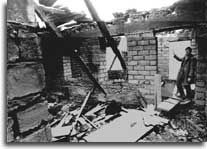 This fact testified that
Armenians had changed their
tactics from that of November
1945.
This fact testified that
Armenians had changed their
tactics from that of November
1945. 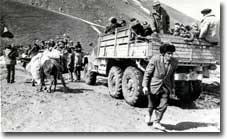 In period of excavation of
Armenian separatists' barbarism
the indifference of the
Communist party of Soviet Union
to the real assessment of the
state of the Central Committee
and Soviet leadership also
became evident. The resolution
"On measures for intensification
of socioeconomic development of
the Autonomous Province of Upper
Karabakh of the Azerbaijan SSR
in 1988-1995" was a bid to cover
up the separatist nature of the
issue. This step inspirited
Armenian separatists and even
increased their aggression.
In period of excavation of
Armenian separatists' barbarism
the indifference of the
Communist party of Soviet Union
to the real assessment of the
state of the Central Committee
and Soviet leadership also
became evident. The resolution
"On measures for intensification
of socioeconomic development of
the Autonomous Province of Upper
Karabakh of the Azerbaijan SSR
in 1988-1995" was a bid to cover
up the separatist nature of the
issue. This step inspirited
Armenian separatists and even
increased their aggression. 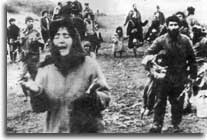 As a result Armenian troops
occupied Shusha in May 1992,
thus invading almost the entire
territory of the Nagorny
Karabakh. The next step was the
occupation of Lachyn, which
served as a corridor between
Nagorny Karabakh and Armenia.
Armenians made use of political
instability in Baku and occupied
Lachyn as well. The fights for
power under the Popular Front
regime from May 1992 to June
1993, significantly weakened the
defensive capacity of
Azerbaijan. In 1993 Armenians
captured Kelbedjar. Azerbaijan
experienced a deep political
crisis in June and in these
conditions by demand of the
population Heydar Aliyev came to
power. Armenia continuing its
war with Azerbaijan invaded
Aghdam, Fuzuli, Djebrayil and
Zengilan between July and
October of 1993.
As a result Armenian troops
occupied Shusha in May 1992,
thus invading almost the entire
territory of the Nagorny
Karabakh. The next step was the
occupation of Lachyn, which
served as a corridor between
Nagorny Karabakh and Armenia.
Armenians made use of political
instability in Baku and occupied
Lachyn as well. The fights for
power under the Popular Front
regime from May 1992 to June
1993, significantly weakened the
defensive capacity of
Azerbaijan. In 1993 Armenians
captured Kelbedjar. Azerbaijan
experienced a deep political
crisis in June and in these
conditions by demand of the
population Heydar Aliyev came to
power. Armenia continuing its
war with Azerbaijan invaded
Aghdam, Fuzuli, Djebrayil and
Zengilan between July and
October of 1993. 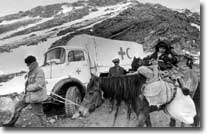 During
the occupation war against
Azerbaijan Armenia moving
forward to 360 kilometers from
the border captured 20% of Azeri
lands, and took control over the
areas from Horadiz district of
Fuzuli till Zengilan and 198
kilometers border between
Azerbaijan and Iran. As a result
of invasions 2 cities, 1
district and 53 villages of
Karabakh with the population of
nearly 50 thousand people were
captured. Beside Karabakh the
military invasions resulted in
occupation of 890 towns,
villages and districts. The
destructed establishments,
occupied sawn areas and
woodlands were as follows:
residential buildings-150000,
public establishments-7000,
secondary schools-693, medical
institutions-695, motor ways-800
km, bridges-160, water
pipeline-2300 km, electric
lines-150000 km,
woodlands-280000 hectares, sawn
areas-200000 hectares,
historical museums and
monuments-464. The damage caused
to the Azerbaijan was initially
estimated to USD 60 billion.
Moreover, the occupied lands
account for all reserves of
mercury, obsidian and pearlite,
35% of building and facing
materials, 23.8% of forests,
7.8% of water reserves and other
riches. Besides, 2 reserves, 3
game reserves and 3 large water
reservoirs locate in these lands
During
the occupation war against
Azerbaijan Armenia moving
forward to 360 kilometers from
the border captured 20% of Azeri
lands, and took control over the
areas from Horadiz district of
Fuzuli till Zengilan and 198
kilometers border between
Azerbaijan and Iran. As a result
of invasions 2 cities, 1
district and 53 villages of
Karabakh with the population of
nearly 50 thousand people were
captured. Beside Karabakh the
military invasions resulted in
occupation of 890 towns,
villages and districts. The
destructed establishments,
occupied sawn areas and
woodlands were as follows:
residential buildings-150000,
public establishments-7000,
secondary schools-693, medical
institutions-695, motor ways-800
km, bridges-160, water
pipeline-2300 km, electric
lines-150000 km,
woodlands-280000 hectares, sawn
areas-200000 hectares,
historical museums and
monuments-464. The damage caused
to the Azerbaijan was initially
estimated to USD 60 billion.
Moreover, the occupied lands
account for all reserves of
mercury, obsidian and pearlite,
35% of building and facing
materials, 23.8% of forests,
7.8% of water reserves and other
riches. Besides, 2 reserves, 3
game reserves and 3 large water
reservoirs locate in these lands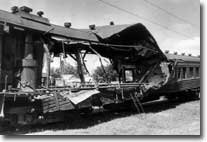 From 1989 to 1994, Armenian
separatists and terrorists
committed 373 terrorist acts in
the territory of Azerbaijan.
These resulted in 1,568 people
killed and 1,808 were injured.
The courts of the Azerbaijan
Republic and foreign countries
proved in a processual order
that 32 out of 373 terrorist
acts were commited with direct
involvement of Armenian
intelligence, which used the
occupied Azeri lands for
damaging settlements 100
kilometers away from the front
line.
From 1989 to 1994, Armenian
separatists and terrorists
committed 373 terrorist acts in
the territory of Azerbaijan.
These resulted in 1,568 people
killed and 1,808 were injured.
The courts of the Azerbaijan
Republic and foreign countries
proved in a processual order
that 32 out of 373 terrorist
acts were commited with direct
involvement of Armenian
intelligence, which used the
occupied Azeri lands for
damaging settlements 100
kilometers away from the front
line.